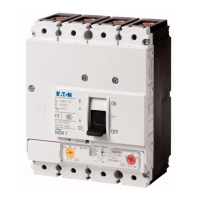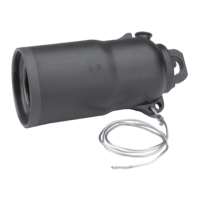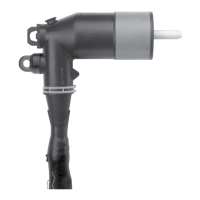Section 4: Control operation
Automatic operation
In the automatic mode of operation, the POWER switch will
be set on INTERNAL and the CONTROL FUNCTION switch
will be placed on AUTO/REMOTE. The regulator is assumed
energized from the primary circuit. If the sequential mode of
operation (the standard mode set at FC 42) is selected, the
control response on Eaton's Cooper Power series voltage
regulator is as follows:
1. As the primary voltage moves to a level which
represents an out-of-band condition, the sensing
voltage will correspondingly reflect the same results
on the 120 V (or 240 V) base. Assuming the voltage
dropped low, a lower than normal signal will appear at
the printed circuit board input terminals.
2. The signal is transformed and converted into a digital
format for use by the microprocessor.
3. The microprocessor, recognizing the voltage condition
as low and out-of-band, issues an output which
activates the Out-of-Band Low indicator and starts an
internal timer, which is equivalent to the time-delay
setting.
4. During the time-out period, the voltage is continually
sensed and sampled. Should the voltage momentarily
move into band, the Out-of-Band Low indicator is
deactivated and the timer is reset.
5. At the end of the time-delay period, the microprocessor
issues an output which causes the raise triac to be
activated.
6. The tap-changer motor begins to turn as a result of
triac closure, and a cam on the tap-changer closes the
raise holding switch. The holding switch now provides
an alternate source for the motor current, which passes
through the input terminals on the circuit board.
7. The microprocessor now recognizes that current is
flowing in the holding switch circuit. The raise triac is
deactivated.
8. As a result of the triac being deactivated, the motor
current is now carried solely by the holding switch
circuit. When the motor rotation is complete, the
holding switch opens as a result of the cam action and
the motor stops.
9. The microprocessor recognizes that the tap change is
now complete by detecting that motor current is no
longer flowing. The operations counter and tap position
indication are incremented. A 2-second pause then
occurs, allowing the sensing voltage to stabilize after
motor operation.
10. At the end of this pause, if the voltage is still out-of-
band, another output is issued to reactivate the raise
triac, thus starting another tap change sequence. If the
voltage is in-band, the OUT-OF-BAND LOW indicator is
turned off and the time-delay timer is reset.
This sequence is altered slightly if the voltage-averaging or
time-integrating mode of operation are selected. These
characteristics are described in Control operating
modes in this section of the manual.
Manual operation
In the manual mode of operation, the POWER switch can
be set on either INTERNAL or EXTERNAL and the control
switch will be placed on LOCAL MANUAL. If the external
position is chosen, an external source must be applied to
the terminals on the control. This should be a nominal 120
Vac source (or other ac voltage as indicated by a decal) and
should not be a direct current to alternating current (dc-to-
ac) inverter.
Operation of the momentary toggle RAISE/LOWER switch
applies power through the position indicator limit switch
contacts directly to the tap-changer motor. As the tap-
changer motor cam rotates, the holding switch is closed,
as described above in the Automatic operation section.
This holding-switch current is sensed by the circuit board,
and the operations counter and tap position indicator are
appropriately updated.
Tap change operation will continue as long as the RAISE/
LOWER switch is held in either the raise or lower position
and the ADD-AMP™ limit switch is not activated to open
the circuit.
Self-test
There are three events which trigger the self-test routine:
the initial control power-up, operator entry of self-test mode
using FC 91, or detection of a firmware problem. Refer to
Section 8: Troubleshooting for more information on control
self-test.
25
INSTALLATION, OPERATION, AND MAINTENANCE INSTRUCTIONS MN225003EN April 2018
CL-7 Voltage Regulator Control

